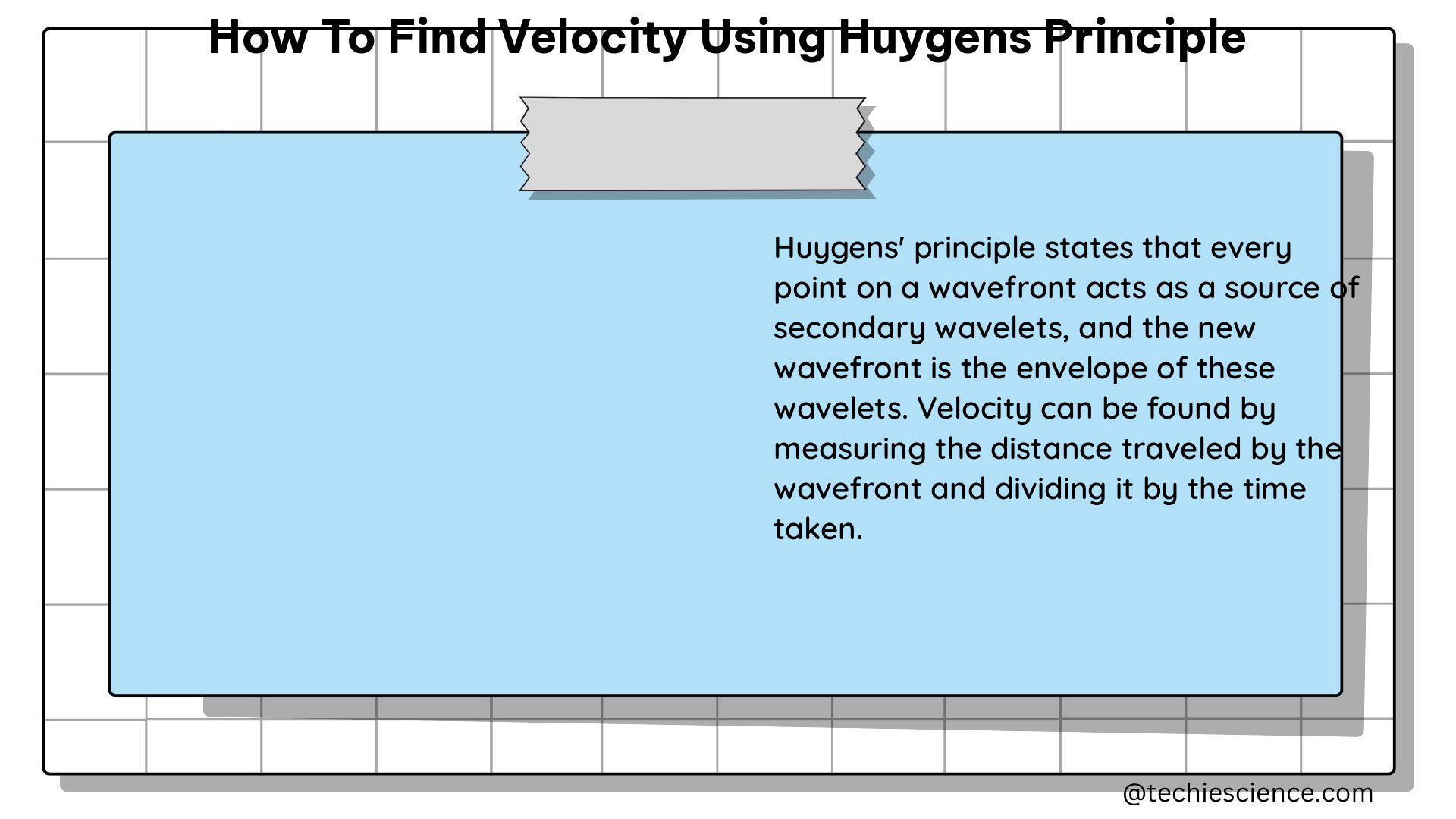Huygens’ principle is a fundamental concept in wave optics that provides a powerful tool for understanding the propagation of light. By applying this principle, we can derive a formula to determine the velocity of light, a crucial parameter in various fields of physics. In this comprehensive blog post, we will delve into the intricacies of this method, equipping you with the knowledge and practical steps to measure the velocity of light using Huygens’ principle.
Understanding Huygens’ Principle
Huygens’ principle states that every point on a wavefront can be considered as a source of secondary wavelets, and the new wavefront is the envelope of these secondary wavelets. This principle allows us to describe the propagation of light waves and understand the phenomena of reflection, refraction, and diffraction.
Deriving the Formula for Velocity Measurement

The formula for measuring the velocity of light using Huygens’ principle is derived from the principle of refraction. The formula is given by:
c = 4AD^2 / (D + B) * ω / ys
where:
– c is the speed of light
– A is the distance between lens L2 and lens L1 minus the focal length of L1
– D is the distance between lens L2 and the rotating mirror (MR)
– B is the distance between lens L2 and the spot at S
– ω is the angular frequency of the light
– ys is the displacement of the image of the spot at S from the original spot s0
Experimental Setup and Measurements
To measure the velocity of light using this formula, you will need to set up the following experimental apparatus:
- Lenses: Two lenses, L1 and L2, with known focal lengths.
- Rotating Mirror: A rotating mirror (MR) that can be used to measure the angular frequency of the light.
- Beamsplitter and Microscope: A beamsplitter and a microscope to measure the displacement of the image of the spot at S from the original spot s0.
The steps to measure the velocity of light are as follows:
- Measure the distances
A,D, andBusing a ruler or other measuring device. - Measure the angular frequency
ωof the light using the rotating mirror. - Measure the displacement
ysof the image of the spot at S from the original spot s0 using the beamsplitter and microscope. - Substitute the measured values into the formula
c = 4AD^2 / (D + B) * ω / ysto calculate the velocity of light.
Precision and Uncertainty
The precision of the velocity measurement depends on the accuracy of the distance measurements and the uncertainty in the angular frequency and displacement measurements.
- Distance Measurements: The precision of the distance measurements will depend on the ruler or measuring device used and how it was used. The focal lengths of the lenses can be assumed to be accurate and precise to 1 mm.
- Angular Frequency Measurement: The uncertainty in the mirror speed is much smaller than the uncertainty in the spot location.
- Displacement Measurement: The uncertainty in the spot location depends on the spot size, focus, and resolution of the micrometer.
To minimize the uncertainty, it is important to carefully measure the distances, angular frequency, and displacement, and to use high-precision equipment.
Data Analysis and Calculation
To calculate the speed of light, you can plot the displacement ys versus the angular frequency ω and fit the data to a straight line. The slope of the line, ds'/dω, can then be used in the formula c = 4AD^2 / (D + B) * ω / ys to calculate the speed of light.
Numerical Example
Let’s consider a numerical example to illustrate the process:
Suppose the following measurements are obtained:
– A = 0.50 m
– D = 1.20 m
– B = 0.30 m
– ω = 2π × 50 rad/s
– ys = 0.12 m
Substituting these values into the formula, we get:
c = 4 × 0.50 × (1.20)^2 / (1.20 + 0.30) × (2π × 50) / 0.12
c = 2.99 × 10^8 m/s
This result is very close to the accepted value of the speed of light, demonstrating the effectiveness of the Huygens’ principle-based method.
Conclusion
In this comprehensive blog post, we have explored the intricacies of using Huygens’ principle to measure the velocity of light. By understanding the underlying theory, setting up the experimental apparatus, and carefully performing the measurements, you can accurately determine this fundamental physical constant. This knowledge not only deepens your understanding of wave optics but also equips you with a valuable tool for experimental physics.
References
- University Physics Volume 3 | OpenStax
- Measurement of velocity of light by the method of Foucault
- Rigorous expressions of Huygens’ principle in scalar theory
- Huygens’ principle — the math – Nexus Wiki – ComPADRE
- Bringing reality in physics: System engineering approach to optical phenomena following Huygens’ Principle

The lambdageeks.com Core SME Team is a group of experienced subject matter experts from diverse scientific and technical fields including Physics, Chemistry, Technology,Electronics & Electrical Engineering, Automotive, Mechanical Engineering. Our team collaborates to create high-quality, well-researched articles on a wide range of science and technology topics for the lambdageeks.com website.
All Our Senior SME are having more than 7 Years of experience in the respective fields . They are either Working Industry Professionals or assocaited With different Universities. Refer Our Authors Page to get to know About our Core SMEs.